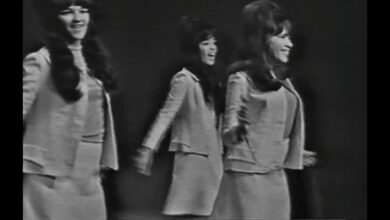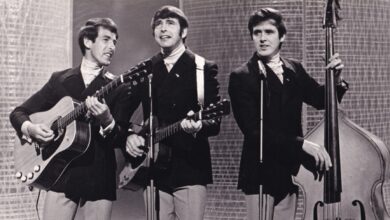The Timeless Brilliance of a 1966 Classic: A Rendition That Redefines Perfection
In the sun-soaked landscape of 1960s California, a group of young musicians emerged, capturing the essence of the American West Coast with their harmonious melodies and surf-inspired tunes. The Beach Boys, formed in 1961 in Hawthorne, California, comprised brothers Brian, Dennis, and Carl Wilson, their cousin Mike Love, and friend Al Jardine. Their early music painted idyllic pictures of surfing, cars, and youthful romance, quickly establishing them as the quintessential American band of the era.
As the band’s primary songwriter and producer, Brian Wilson was the creative force behind their evolving sound. While their initial hits celebrated the carefree Californian lifestyle, Wilson’s artistic ambitions soon led him to explore more complex musical landscapes. This shift was evident in their 1966 album, *Pet Sounds*, which showcased sophisticated arrangements and introspective themes, marking a departure from their earlier, more straightforward pop songs.
Amidst this period of innovation, Wilson conceived a song that would become one of the band’s most iconic tracks: “Good Vibrations.” The inspiration for the song’s title stemmed from a childhood conversation with his mother, who suggested that dogs could sense “vibrations” from people, leading them to bark at those with bad vibes. This idea of unseen energies resonated with Wilson and became the conceptual foundation for the song.
The recording process for “Good Vibrations” was nothing short of revolutionary. Unlike the typical approach of recording a song in a single session, Wilson adopted a modular method, recording various segments of the track across multiple studios over several months in 1966. This technique allowed him to experiment with different sounds and arrangements, ultimately piecing together the final version like a musical mosaic.
Collaborating with lyricist Mike Love, Wilson crafted a song that seamlessly blended diverse musical elements. From its cello-driven bass lines to the ethereal tones of the theremin, “Good Vibrations” defied the conventional pop structures of its time. The lyrics, celebrating a mystical connection with a girl, complemented the song’s innovative soundscapes, creating a track that was both avant-garde and accessible.
Upon its release on October 10, 1966, “Good Vibrations” was met with both critical acclaim and commercial success. The song soared to the number one spot on the Billboard Hot 100 chart in December of that year, becoming the band’s third chart-topping single in the United States. Its success wasn’t limited to America; the track also reached number one in the United Kingdom, marking The Beach Boys’ first British chart-topper.
The song’s impact extended beyond the charts. “Good Vibrations” was hailed as a masterpiece of pop music, with its innovative production techniques influencing countless artists and producers. The track’s success also solidified The Beach Boys’ reputation as pioneers in the music industry, capable of pushing creative boundaries while maintaining mainstream appeal.
Following the triumph of “Good Vibrations,” Wilson embarked on an ambitious project titled *Smile*, envisioned as a “teenage symphony to God.” Collaborating with lyricist Van Dyke Parks, Wilson sought to create an album that would surpass even the innovations of *Pet Sounds*. However, the project’s complexity, combined with personal and professional challenges, led to its shelving in 1967, leaving fans and critics to wonder about the album that might have been.
Despite the challenges surrounding *Smile*, the legacy of “Good Vibrations” endured. The song’s groundbreaking use of modular recording and its fusion of diverse musical elements set a new standard for pop music production. Artists across genres drew inspiration from its innovative approach, cementing its place as a landmark in music history.
In the years that followed, The Beach Boys experienced various trials, including internal conflicts and personal struggles. Brian Wilson, in particular, faced mental health challenges that impacted his involvement with the band. Nevertheless, the group’s influence remained undeniable, with “Good Vibrations” standing as a testament to their creative genius and enduring appeal.
The song’s cultural significance was further recognized through various accolades. In 1994, “Good Vibrations” was inducted into the Grammy Hall of Fame, honoring its lasting impact on the music industry. Additionally, numerous publications have ranked it among the greatest songs of all time, highlighting its innovative composition and production.
Over the decades, “Good Vibrations” has been covered and referenced by numerous artists, reflecting its enduring influence. Its distinctive melody and innovative structure have inspired musicians across genres, from rock to electronic music, underscoring its timeless appeal.
The song’s legacy also extends to its live performances. Despite the complexities of its studio production, The Beach Boys have incorporated “Good Vibrations” into their concert repertoire, often as a highlight of their shows. These performances serve as a testament to the song’s enduring popularity and the band’s commitment to their musical heritage.
In reflecting on “Good Vibrations,” it’s evident that the song represents a pinnacle of creative achievement for The Beach Boys. Its innovative production, combined with its commercial success, exemplifies the band’s ability to blend artistic experimentation with mainstream appeal. The track remains a defining moment in their discography and a milestone in the broader landscape of popular music.
Today, “Good Vibrations” continues to resonate with audiences, both old and new. Its timeless quality and innovative spirit ensure that it remains a staple of classic rock playlists and a subject of study for music enthusiasts. As a testament to The Beach Boys’ enduring legacy, the song stands as a beacon of creativity and a reminder of the transformative power of music.
In conclusion, “Good Vibrations” is more than just a song; it’s a cultural touchstone that encapsulates a moment of artistic innovation and expression. Its creation, success, and lasting impact reflect the genius of The Beach Boys and their ability to capture the essence of an era while transcending it. As we continue to experience its “good vibrations,” the song remains a timeless reminder of the boundless possibilities of musical creativity.



